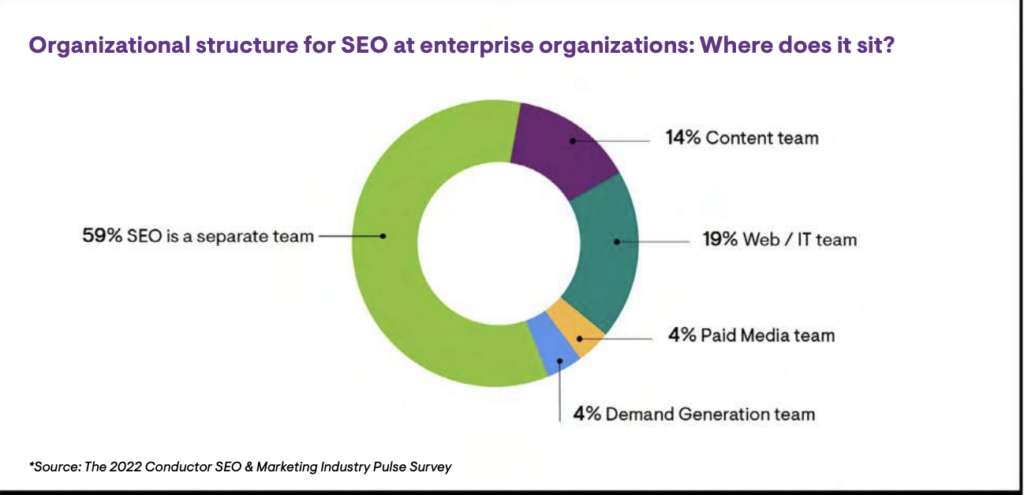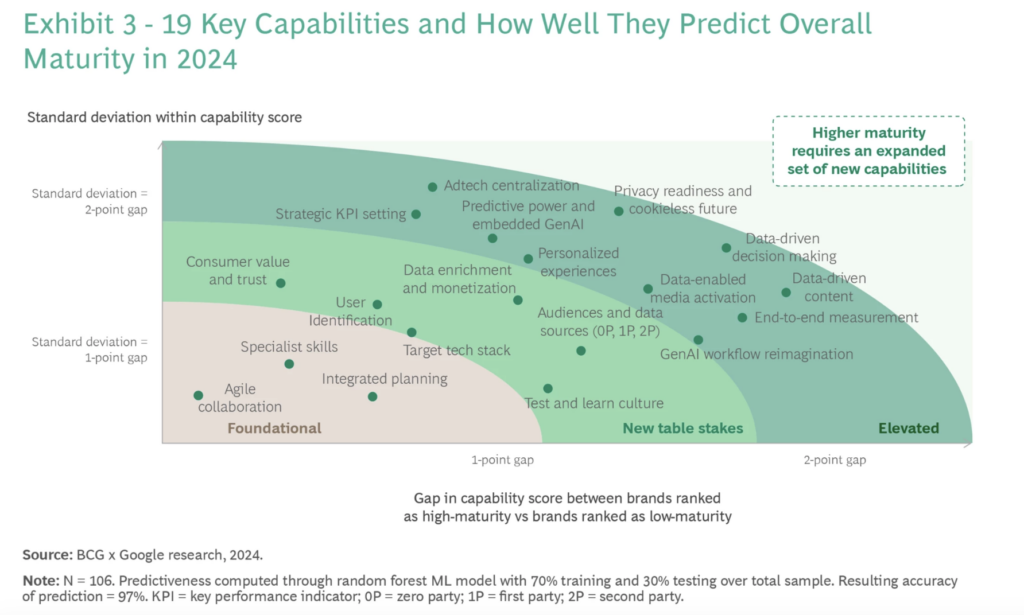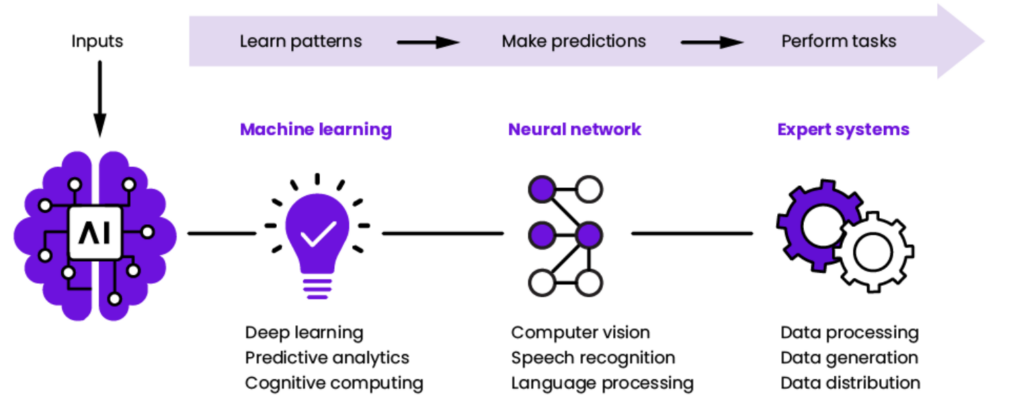The role of marketers is quickly changing in the age of AI and other catalyst market forces. The people, processes, and technologies put in place years ago to streamline marketing efficiencies and drive outcomes require a shift to remain competitive today. Let’s examine how organizations can future-proof operations and elevate team capabilities to move toward marketing maturity.
Build for Integrated Teams
Gartner research indicates that AI will overhaul an estimated 75% of marketing production responsibilities over the next two years. Alongside this shift, digital experiences are becoming more fluid, integrated, and nonlinear than ever. We see this being played out in real-time with the latest integrations of Google search results into Meta AI, social conversations across Reddit and TikTok into search platforms like Google, and Google Ad’s Performance Max continuing to shift the advertising platform away from single-channel ad delivery.
Our research indicates that by 2025, organizations that use AI across the marketing function will shift 75% of their staff’s operations from production to more strategic activities.
As cross-platform experiences converge and AI alters day-to-day marketing responsibilities, specialized roles managing siloed experiences across owned, earned, and paid media must be reimagined. The graph below from a 2022 SEO & Marketing Industry Pulse Survey by Conductor highlights the difficulties that can come from highly specialized and decentralized marketing teams. When several teams sit in specialized silos across an organization, these fractions can lead to increased overhead to maintain cross-department communications and often result in misaligned expectations and outcomes. It’s essential to upskill and integrate marketers using an omnichannel lens to mature toward customer-centric, not channel-specific, capabilities.

In 2022, 65% of B2B and B2C organizations surveyed by Gartner migrated to “fully” or “partially” centralized structures to alleviate decentralized challenges, including prioritization, workflow, budget, and growth. In a centralized framework, decentralized (siloed) marketing teams are consolidated into one team where a senior leader controls strategy, workflows, and processes. This framework brings with it several benefits:
Brand Consistency: A centralized team ensures consistent messaging, visual identity, and brand voice across all initiatives.
Improved Efficiency and Scalability: Streamlined workflows, standardized processes, and shared resources eliminate redundancies, allowing teams to scale marketing efforts quickly and efficiently as the business grows.
Data-Driven Insights: Centralized data collection and analysis provide a comprehensive view of marketing performance.
While centralized frameworks can help teams move closer toward integration and alignment, they don’t automatically solve for leveling up capabilities and workflows.
Elevate Capabilities with AI
Boston Consulting Group found that AI is one of four market disruptors that can make or break brand productivity, profitability, and overall competitiveness. Adopting AI to evolve new capabilities is required to mature marketing operations.
Data-driven marketing is evolving so quickly that the average level of marketing maturity actually fell by 8% from 2021 to 2024. Brands can unlock maturity benefits by leveraging the right capabilities through strategic decision making, integrated teams, actionable data, and smart execution.
Accelerating AI-Driven Marketing Maturity, Boston Consulting Group

Customer-Centric Strategies with Actionable Audience Data
AI-driven predictive analysis is the future of audience research and customer-centric strategies. Beyond descriptive analytics, like historical data in Google Analytics, CRMs, or social platforms, predictive analytics tools help marketers identify past behavior patterns and indicators that can inform future outcomes.
Types of data to inform predictive outcomes include:
- Browsing and purchase history
- Social media interactions
- Demographic trends and behavioral data
- Customer service interactions
- Customer feedback through surveys
As you’ve probably guessed, this requires a certain level of accessible and integrated ZPD, 1PD, and 3PD sources. Luckily, commonly used martech platforms offer predictive analysis tools.
ZPD, Engaged Audiences: Hubspot Predictive Lead Scoring, SalesForce CRM Analytics, Klaviyo AI
1PD, Interacted Audiences: GA4 Predictive Audiences, Adobe Analytics Predictive Analytics
3PD, Unknown Audiences: Microsoft Predictive Targeting, Google Ads Performance Max, Meta Advantage+ Audiences
Other important audience research platforms support actionable audience data without predictive analytics. Platforms like Sparktoro are especially important to omnichannel audience research as they allow teams to access real-time 3PD across owned and earned media channels. Other owned and earned martech only offer audience insights within their respective channels. Leveraging a platform that unites cross-channel audience insights is invaluable for maturing marketing teams.
Before introducing new martech, it’s best to assess your existing platforms for predictive features. You’ll be surprised at how many AI features are available within platforms your teams already use but are not widely adopted into daily operations. Once audience research tools and processes are established, continually uncovering the most valuable opportunities and forecasting outcomes supports the next phase, smart execution through automation.
Smart Execution Through Automation
Predictive Personalization
Leveraging predictive analytics to tailor personalized messaging to individual customers is the gold standard in marketing automation. Mature marketing teams can leverage AI inputs to anticipate customer expectations and proactively automate messaging needs. Customer relationship platforms like Klayiyo are leaning heavily into the power of predictive analysis to automate personal experiences that drive value. Brands are also training chatbots to predict customer sentiment and manage messaging based on conversations with sales and accounts teams.
Again, assessing your existing martech and processes is key to enabling mature capabilities. Your team needs access to the right tools to upskill for the right jobs.
Data-Driven Content Generation
What used to take marketers, copywriters, designers, and project managers weeks to develop collaboratively can now be built in literal minutes with AI. Marketing’s new role in content production is to guide AI tools with the right inputs and oversee outputs to ensure they’re of high quality and aligned with the brand, the strategy, and the human experience.
Owned Content: Leveraging AI to generate data-driven content offers unmatched efficiencies. Tools like SEMRush’s AI Writing Assistant enable marketers to go from article ideation to optimized content development without building robust guides for copywriters. Klaviyo, Hubspot, and Hootsuite offer AI features to support personalized content generation across social and email.
Advertising Content: We’re far beyond the days of guessing best-performing headlines and ad sizes and assigning a design resource to resize hundreds of campaign images. Elevate AdOps efficiencies with AI features like Performance Max and Demand Gen image tools in Google Ads, Copilot in Microsoft Advertising, and Image Expansion in Meta for Business to scale assets that leverage in-platform audience data to inform reach and engagement opportunities.
Standardize Evolving Workflows
After teams assess and discover new ways to automate their work, there needs to be a level of governance and standardization. You guessed it: There are ways to document and automate workflows with AI. Asana recently announced its new AI feature, which will support teams in building automated workflows that align tactical production needs with goals and reporting. There is no shortage of tools, likely within your existing martech, to help you scale and manage evolving workflows for teams to ensure all outputs are on brand and aligned with OKRs.
Summary
The biggest takeaway is that you don’t have to blow up your existing operations or martech to elevate your marketing teams. Small steps towards integrated teams and AI adoption can make a huge difference in your operations and outcomes. If integrating your teams is a long play, assess your existing data streams and martech for redundancies and AI efficiencies. Empower your managers with the opportunity to evaluate the tools they use every day and provide recommendations to upskill and elevate their work. Make organizational transformation towards mature marketing a collaborative effort.
Did you find this article interesting? Don’t forget to share.
Keep up with more evolving search trends by following us on LinkedIn.
How To Reshape Your Marketing Program
We recently performed a marketing gap analysis for a client. The goal was to understand…
As New AI Search Platforms Emerge, How to Win Visibility is Fundamental
The race for AI search platforms is heating up. Perplexity, an AI-driven search platform developed…





